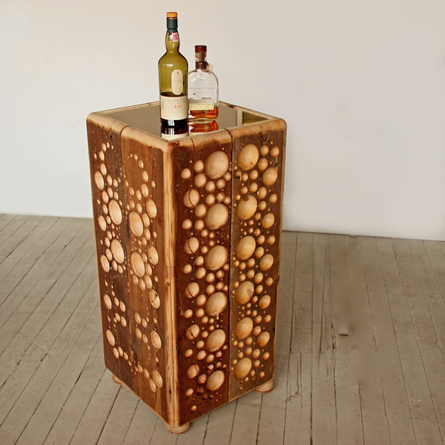New York's Wanted Design, an international design event wrapped up earlier last week and lived up to its hype as one of the most interesting and well curated shows of NYC Design Week. A feast for the eyes and fuel for the imagination, the show is a platform for international designers, architects, interior designers, craftsmen, manufacturers and students to feature their latest inspiring creations. Here's a taste below of what we saw...
Transformation was a prevalent theme throughout the show, the
inspiration for which ranged from sustainable reuse, art, preservation and
more. From a delicate vase that transforms air into form, to a sink (Synk)
that transforms sound waves into visible waves, to the unique and fun
reclamation of big city taxi lights into energy-efficient LED lights for the
home - the event didn't disappoint! One of my favorite pieces, the lights (pictured above), display eight different configurations and are perched
on a metal base, mimicking the taxi rooftops they once graced.
The sustainable lighting of New Zealand artist, David Trubridge
pushes the boundaries of design with a mesmerizing collection that transforms
light. Featuring Ikea-like kits of
bamboo sections for assembly into functional and artistic pendant lights (also
available as reassembled styles in anodized aluminum for outdoor use). The
collection also features magnificent, 8-foot, large scale fixtures that flood
open spaces with light and shade producing transfixing shadows and ambiance.
Student innovation took center stage as the second year of the
Metaproject showcased the partnership between the Rochester Institute of
Technology School of Design students and this year's industry partner, the
Corning Glass Museum.
Students were tasked with transforming recycled glass into a
usable domestic vessel. Some of the most practical and useful concepts presented
include:
Another favorite of mine was USB jewelry - a fashionable, wearable vessel
for data made from a USB and the neck of a wine bottle. The high tech design jewelry encases
the USB in a way that protects as well as allows it to switch back and forth
for easy use.
Pictured above, is an innovated solution for juggling both a
cocktail and a plate of hors d'oeuvres at a party, leaving one hand free for
greeting other guest uses recycled glass.
If you take the time to review all the Metaproject entries
you will not be disappointed and it will reaffirm that American ingenuity is
alive and well in the next generation of designers.
12 X 12 NYC, which
advocates for increased lumber reclamation within New York while also
benefiting the under served population of the city was one of the most
impressive exhibits. Supplying twelve contemporary furniture designers with the
reclaimed wood of twelve demolished New York City buildings with the goal of of
transforming the spirit of these classic structures into contemporary designs. The salvaged woods represent a range of structures, historical
eras and species - from the old growth Pine of the American Express stables in
Soho to Brazilian Ipe from the Coney Island boardwalk.
12 X 12's twelve furniture creations will be auctioned off on May 25th with proceeds
to benefit woodworking education and job training in New York City through the
not-for-profit Brooklyn Woods. Through their efforts, the furniture makers were able to
transform the crumbling remains of the city into beautiful, functional pieces
while transforming lives with job training for the under served of the
community.
Above is artist Fiyel Levent’s liquor cabinet is made out of
Antique Spruce, from the now defunct but beloved East Village Mars Bar. It's just one of the many stunning creations showcased at the Wanted Design 2012 event!









